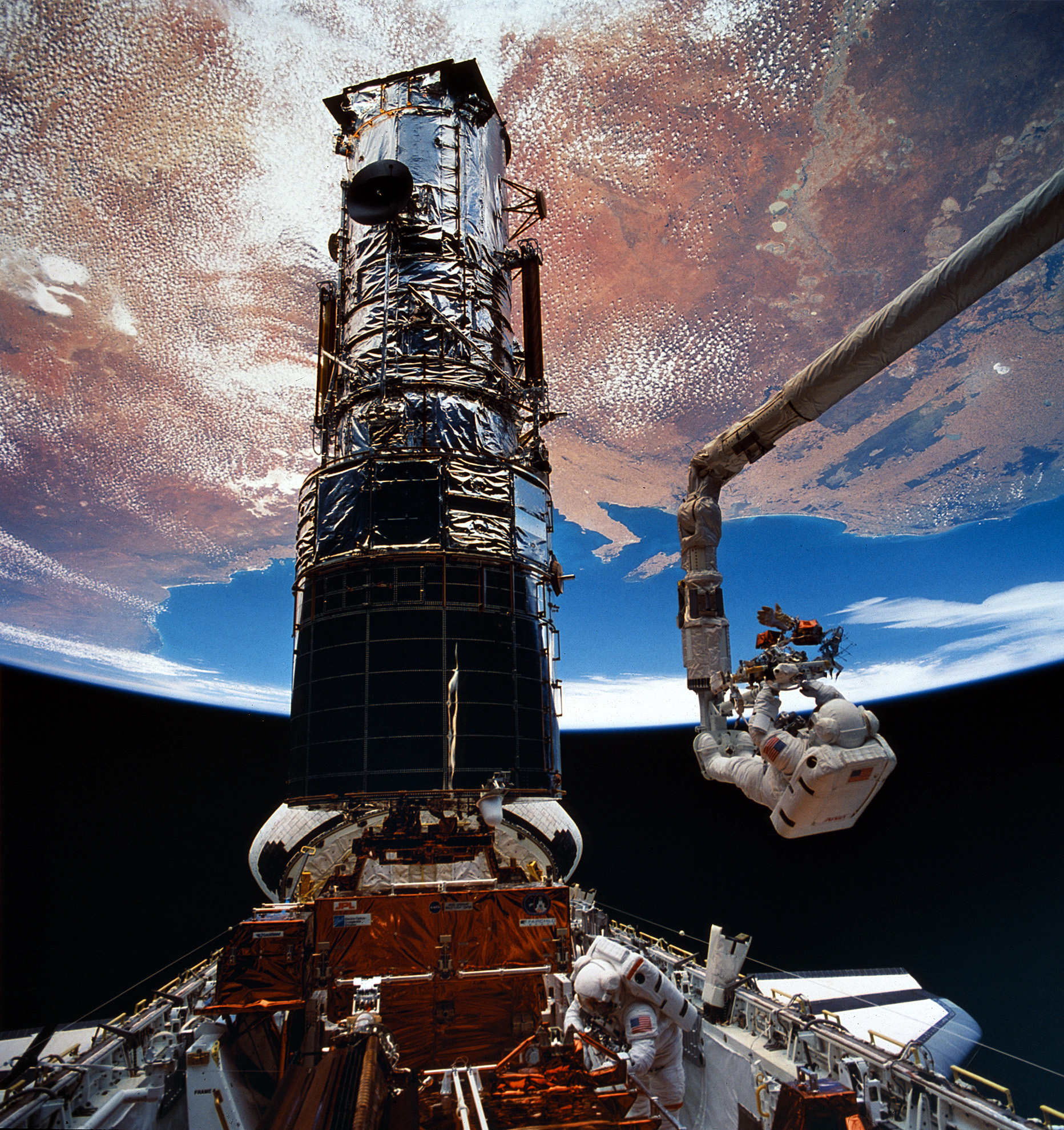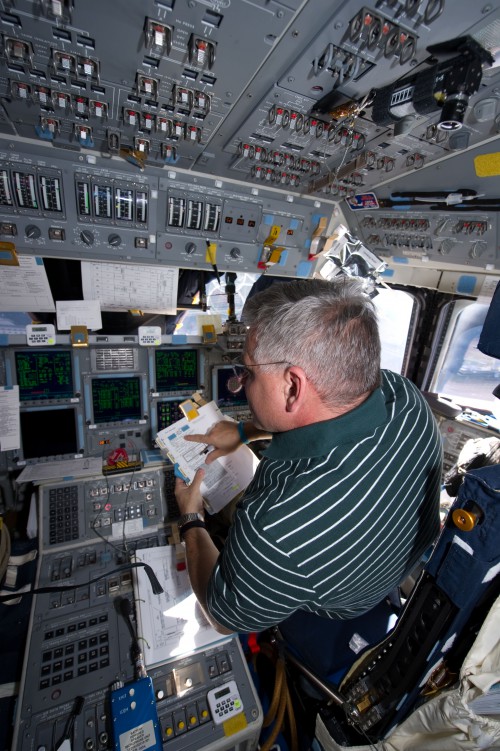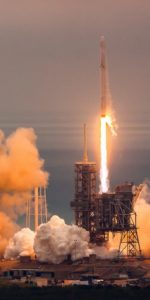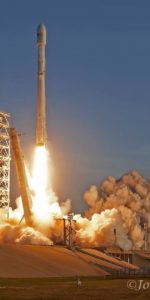
Twenty-five years have now passed since the maiden voyage of Endeavour, the youngest member of NASA’s Space Shuttle fleet, which went on to complete no less than 25 missions into low-Earth orbit during the course of her career. As detailed in yesterday’s AmericaSpace history article, Endeavour—also known as Orbiter Vehicle-105 (OV-105)—arose as the replacement for the fallen Challenger and launched for the first time on 7 May 1992. From the outset, she began to set records. Her nine-day STS-49 flight was the longest maiden voyage of any of the shuttles and, even today, she retains a unique record for having staged and first (and only) three-person Extravehicular Activity (EVA).
Truly, Endeavour’s career would see the shuttle program live up to its original billing: shuttling hardware and humans from terra firma to low-Earth orbit.
STS-49 was tasked with the retrieval, repair and redeployment of the Intelsat 603 satellite, a critical telecommunications platform which was destined to provide coverage of the 1992 Summer Olympics in Barcelona. Its Commercial Titan III launch vehicle had failed to properly insert it into geosynchronous orbit and instead left it lingering in low-Earth orbit. Under a $90 million contract between the satellite’s manufacturer, Hughes, and NASA, the giant Intelsat would be brought into Endeavour’s payload bay, whereupon a new rocket motor would be fitted by STS-49 spacewalkers Pierre Thuot and Rick Hieb and it would be reboosted to geosynchronous altitude.
The early part of the mission did not go well. Although the rendezvous was successfully completed, two back-to-back EVAs by Thuot and Hieb failed to install a capture bar and physically seize the satellite, forcing some radical thinking: in the world’s first-ever—and so far only—three-man EVA, astronauts Thuot, Hieb and Tom Akers ventured outside together to manually grab Intelsat and bring it into Endeavour’s payload bay. It was a remarkable success and a remarkable example of NASA’s can-do spirit. The mission concluded with a record-breaking fourth EVA, in which Akers and astronaut Kathy “K.T.” Thornton rehearsed Space Station Freedom construction techniques and a landing which showcased the shuttle’s safety-enhancing drag chute.

Four months later, in September 1992, on STS-47, Endeavour roared aloft a second time, carrying the Japanese Spacelab, dedicated to life sciences and materials research in the strange microgravity environment. Amongst the crew was the first black female astronaut, Mae Jemison, and Japan’s first professional spacefarer, Mamoru Mohri, together with the first married couple ever to journey into orbit together, Mark Lee and Jan Davis. Another four months elapsed before she flew STS-54 in January 1993, launching a Tracking and Data Relay Satellite (TDRS) and featuring a dramatic EVA by astronauts Greg Harbaugh and Mario Runco. It had long been recognized that as the Space Station era approached, more EVA experience was acutely necessary and both STS-54 and Endeavour’s next pair of missions would truly push the envelope.
The first of those missions, STS-57 in June 1993, already promised to be exciting, ahead of launch, since it marked the debut of the first commercial Spacehab science module and the retrieval of the European Retrievable Carrier (EURECA) free-flying satellite. When an EVA by astronauts David Low and Jeff Wisoff was added, it intensified the drama. Yet that EVA was itself enhanced when one of EURECA’s antennas failed to properly latch into place and needed a helping hand from the spacewalkers. More helping hands were needed in December, when the crew of STS-61 supported no fewer than five EVAs—a new shuttle record, equaled, but never surpassed—to triumphantly service and install corrective optics on the Hubble Space Telescope (HST).
Following the high drama of her 1993 missions, Endeavour transitioned to the role of a pathfinding science platform in 1994, supporting a pair of Space Radar Laboratory (SRL) missions (STS-59 and STS-68) in April and September to map Earth’s surface in unprecedented detail using a powerful synthetic aperture radar in the payload bay. Her longest voyage of all, STS-67, followed in March 1995, when she flew her first and only Extended Duration Orbiter (EDO) mission, lasting almost 17 days. It was a record length for the shuttle program and would kick off a 15-month period in which sister ship Columbia would not hold the record for the program’s longest mission.
Three subsequent missions were marked by the fact that they deployed and retrieved satellites from orbit…and supported EVAs. STS-69 in September 1995 was the first “double” deployment and “double” retrieval mission, launching and picking up both the Wake Shield Facility (WSF) and the Spartan satellites and staging another Station-related EVA by astronauts Jim Voss and Mike Gernhardt. Retrieval of Japan’s Space Flyer Unit (SFU) in January 1996, coupled with the release and recovery of another Spartan free-flyer and a pair of EVAs featuring three astronauts—Leroy Chiao, Dan Barry and Winston Scott—formed the basis of STS-72 and Endeavour’s 11th voyage, STS-77, in May of that year became the first shuttle flight to support as many as four discrete satellite deployments.
After STS-77, Endeavour was extensively modified to support missions to Russia’s Mir space station and the International Space Station (ISS). Her EDO provisions were removed and in January 1998 she flew STS-89—the second-to-last shuttle docking flight to Mir—which exchanged astronaut Dave Wolf for Andy Thomas. Next came the epochal STS-88 in December, the first flight to transport U.S.-fabricated equipment into orbit for the assembly of the ISS. During 12 days in orbit, Endeavour’s crew rendezvoused and docked with the Russian-built Zarya control module and attached the Unity node.
It was the beginning of a new era. Only one more “stand-alone”, non-station-related mission would take place for Endeavour. In February 2000, she flew the Shuttle Radar Topography Mission (SRTM), which used much of the Space Radar Laboratory hardware to map Earth’s surface, together with a long interferometry mast, which provided additional three-dimensionality to the resultant radar images.

Following STS-99, the remainder of Endeavour’s career would be exclusively devoted to ISS construction and maintenance. First, she brought power: in December 2000 her STS-97 crew installed the first set of port-side solar arrays, followed by Canada’s robotic arm in April 2001 on STS-100 and three logistics and crew exchange missions on STS-108 in December 2001, STS-111 in June 2002 and STS-113 in November 2002. The last of these flights was a particularly poignant, coming just weeks before the tragic loss of Columbia, which would bring the entire shuttle fleet to its knees for more than two years.
Endeavour would remain grounded until August 2007, when (to an extent) she fulfiled her mandate as Challenger’s replacement by carrying the backup candidate to teacher Christa McAuliffe into orbit. Barbara Morgan had trained in McAuliffe’s shadow, all those years before, and had witnessed the disaster which tore out NASA’s heart in January 1986, before returning to teaching. However, space exploration continued to call Morgan and in August 1998 she was selected for NASA Mission Specialist training. Nine years later, on STS-118, she finally got her chance to fly.
A trio of 16-day missions followed, with STS-123 in March 2008 carrying the logistics module for Japan’s Kibo complex and Canada’s Dextre robotic “hand” to the station, STS-126 in November 2008 carrying the first provisions for six-crew capability and STS-127 in July 2009 carrying the outside porch and equipment for Kibo. All three missions featured some of the most complex EVAs ever attempted. By the end of 2009, Endeavour had flown 23 times into space—more than twice as many as Challenger—and had only two more missions ahead of her. STS-130 in February 2010 delivered the Tranquillity node and the multiple-windowed cupola to the station, whilst her final mission, STS-134, in May 2011, attached the Alpha Magnetic Spectrometer (AMS) onto the exterior of the near-complete international complex.
All told, across her 25 flights, Endeavour safely protected the lives of 148 astronauts and cosmonauts—including citizens of Japan, Switzerland, Russia, Canada, Germany, Italy, France and the United States—and spent 299 days in low-Earth orbit. She circled the Home Planet more than 4,670 times and traveled in excess of 123 million miles (198 million km).
During her career, Endeavour’s astronauts performed 54 spacewalks to practice building space stations and actually assembling and maintaining the real thing on no fewer than 12 missions. In the process, she became the first shuttle to stage as many as four and five EVAs, on a single flight. From her airlock, the very first ISS-related spacewalks got underway in December 1998, and it was whilst Endeavour was in residence at the space station that the last EVAs of the Space Shuttle era took place.
With the completion of STS-134 on 1 June 2011, Endeavour was retired, alongside her two surviving sisters, Discovery and Atlantis. Her retirement home is now the California Science Center in Los Angeles, where thousands of visitors have paused to admire a quite remarkable machine which truly defined a generation.
This is part of a series of history articles, which will appear each weekend, barring any major news stories. Next week’s article will continue the focus on Endeavour’s 25th anniversary, looking back at the starting voyage of her career: the ambitious mission of STS-49.
Be sure to “LIKE” AmericaSpace on Facebook and follow us on Instagram & Twitter!






Hopefully, History Will be Kind to the NASA SST Space Shuttle Age. And Thank You Ben for each & every tale you Share with Us…
Dave